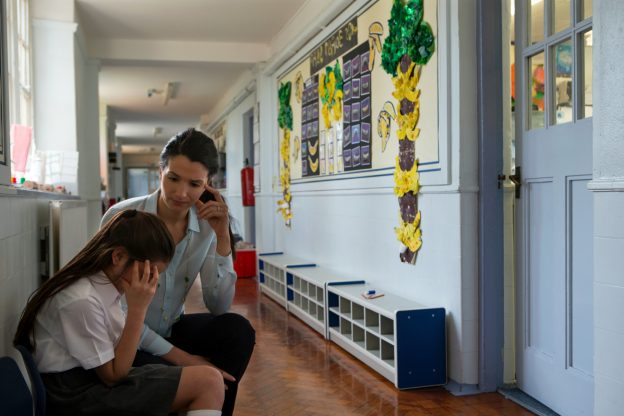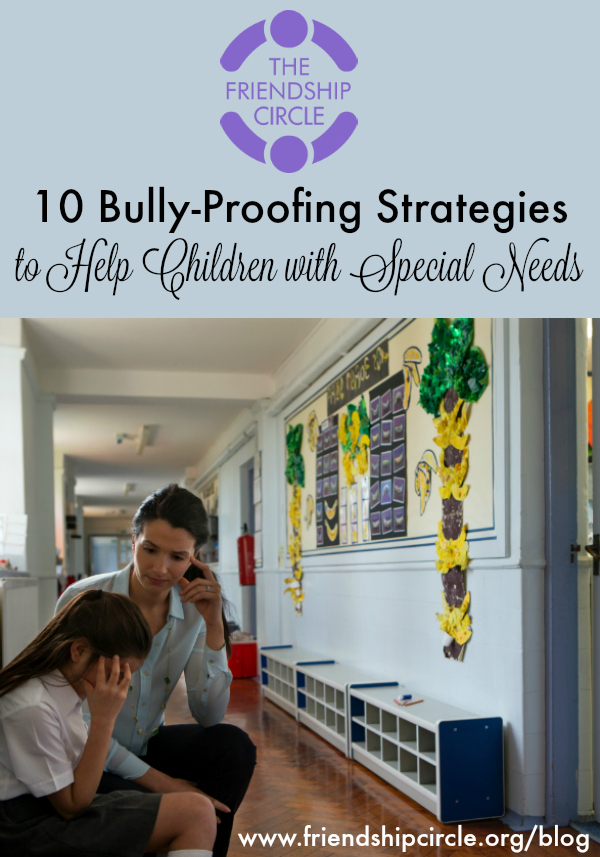
Parenting, Special Education 
10 Bully-Proofing Strategies to Help Children with Special Needs
Bullying is in the news all the time lately, and as a former special education teacher I know that children with special needs are targeted all too frequently. And they are so for a number of reasons. Special needs kids may be less mature than peers, exhibit quirky behaviors, or have a difficult time reading facial expressions, body language or verbal cues. They may be quick to anger or have poor impulse control. And sadly, kids who seem vulnerable or “different” fall victim to a bully’s cruelty. Studies find that students with Autism Spectrum Disorder (ASD) are especially vulnerable to bullying. One large survey found that children attending regular public schools with ASD are bullied at a rate of nearly 50 percent more than kids in private school or special education settings. Another study discovered that students entering first grade with signs of depression and anxiety or excessive aggression are at risk of being chronically victimized by classmates by third grade. Research also shows that children with Attention Deficit Hyperactivity Disorder (ADHD) are almost 10 times as likely as others to have been regular targets of bullies. Whatever the reason, bullying should never be tolerated, and parents play a key role in helping to assure their children’s safety. The first step to stopping bullying is to understand the definition. Bullying is not mere teasing. Bullying is intentional, negative behavior and never an accident. It always involves a power imbalance: the bully targets a child who has “unequal footing” (or cannot hold their own) due to less power, status, or size. And bullying is almost always repeated, and this is why it must be stopped. So what can a parent of a special needs child do to prevent bullying? Here are ten tips.1 | Check your child’s school anti-bullying policy
All 50 states have passed anti-bullying policies and your child’s school must have one. Ask for a copy of the school’s policy.2 | Find where to report bullying
Check your school’s website and handbook for where parents and students should report bullying. If there isn’t a policy, share your concerns with the principal.3 | Explain bullies’ behavior
You might explain that bullies often pick on those who are smaller or weaker to feel powerful or better about themselves. Stress that bullies usually love reactions: “So try to be calm and don’t react, so the bully recognizes that his antics won’t work.” Then, practice ways for your child to appear calmer (even though he’s trembling inside). And develop a phrase your child can say inside his head to counter the taunt: “I don’t deserve this” or “Stay cool!”4 | React calmly
Targeted children worry that parents may make things worse by insisting the bully is disciplined (which could mean retaliation). Reassure your child that you will help, but don’t promise to not tell adults in authority. You may need to advocate for his safety.5 | Develop a bully-proofing strategy
A plan might be to say: “Stop that!” or “Cut it out!” in a firm voice to the tormentor (and loud enough to get the attention of a nearby adult). Walk towards an adult or supportive group of peers. Or, develop a private code so your child can feel safe notifying his teacher. Practice repeatedly so your child is ready with things to say or do.6 | Create a safety plan
Bullying is almost always a repeated pattern and usually happens at the same place and time. Identifying “when and where” the bullying happens will help you create a safety plan for your child. For instance, if it’s bullying is: In the back of the bus, “Sit in the front.” On the playground: “Stand closer to the supervisor.” At the locker: “Carrying your books in your backpack.”7 | Don’t try to go alone
Get the help of other adults in the child’s life – be it a teacher, grandparent, school counselor or coach. Success is always more likely when all adults are onboard together to support a child and use the same behavior intervention.8 | Track evidence
Keep an ongoing record of times, dates, witnesses and locations of any bullying incidents. Share those with your child’s teacher. Reinforcing the same bullying prevention plan with school personnel is crucial for success.9 | Surround the child the supportive people
Make sure your child knows which staff members and peers he can go to for support. Every child needs an ally-especially one with special needs.10 | Be Vigilant!
If a school is unable or unwilling to provide your child with proper support, or if he continues to be targeted, consider changing schools or homeschool. But keep in mind that your child will still need to a repertoire of skills to navigate the all-too vicious social jungle.For more, check out: The 6Rs of Bullying Prevention: Best Proven Practices to Combat Cruelty and Build Respect (Free Spirit Press) by Dr. Michele Borba.
Has YOUR child been bullied?
Please leave your comments below!




